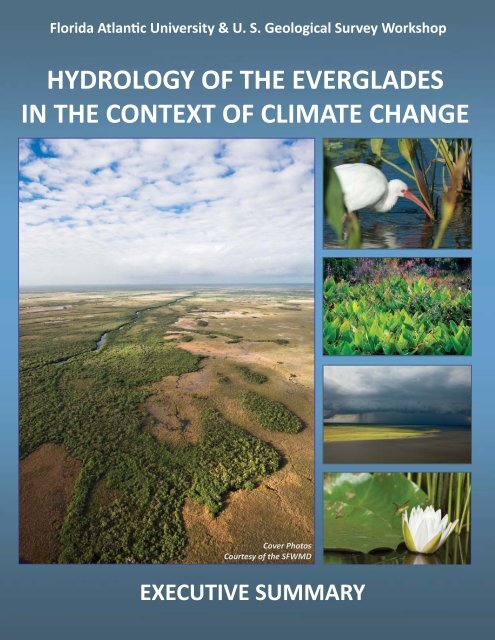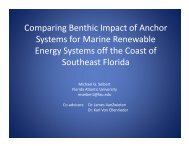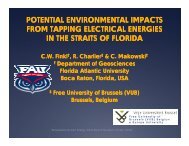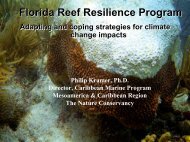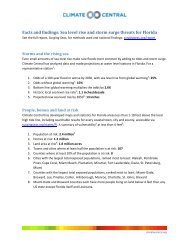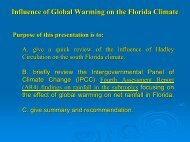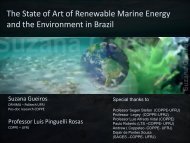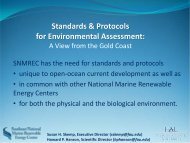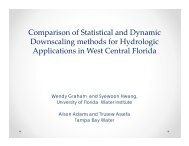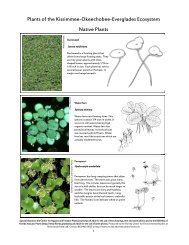Executive Summary - Florida Center for Environmental Studies - Fau ...
Executive Summary - Florida Center for Environmental Studies - Fau ...
Executive Summary - Florida Center for Environmental Studies - Fau ...
You also want an ePaper? Increase the reach of your titles
YUMPU automatically turns print PDFs into web optimized ePapers that Google loves.
<strong>Florida</strong> Atlantic University & U. S. Geological Survey Workshop<br />
HYDROLOGY OF THE EVERGLADES<br />
IN THE CONTEXT OF CLIMATE CHANGE<br />
Cover Photos<br />
Courtesy of the SFWMD<br />
EXECUTIVE SUMMARY
BACKGROUND<br />
The <strong>Center</strong> <strong>for</strong> <strong>Environmental</strong> <strong>Studies</strong> (CES) at <strong>Florida</strong><br />
Atlantic University (FAU) and the U.S. Geological Survey<br />
(USGS) held a workshop on March 29-30, 2012 at<br />
FAU in Davie, <strong>Florida</strong>. The purpose of this workshop<br />
was twofold:<br />
• Assess the state of knowledge of the impacts of<br />
current and future climate change on the hydrological<br />
cycle in the Everglades including gaining a<br />
greater understanding of downscaled hydrologic<br />
global models <strong>for</strong> the Everglades.<br />
• Examine each of the components of the cycle in<br />
the greater Everglades by identifying:<br />
• our understanding of potential changes in precipitation<br />
quantity and intensity, evapotranspiration,<br />
percolation to groundwater, runoff<br />
and drainage, and<br />
• critical knowledge gaps with respect to future<br />
patterns and their impact.<br />
The plenary sessions opened with a series of presentations<br />
that set the stage by providing a common basis<br />
of in<strong>for</strong>mation <strong>for</strong> the discussion groups to draw<br />
upon. The first group of speakers provided a “Big Picture<br />
Perspective” on the climate change implications<br />
<strong>for</strong> <strong>Florida</strong>, including the state of knowledge, downscaling<br />
global models and changes in hydrology. This<br />
was followed by a review of selected components of<br />
the hydrological cycle, including precipitation, temperature,<br />
evapotranspiration and groundwater and<br />
surface water flows. More importantly the idea of<br />
this workshop was to focus on the impact of global<br />
climate change on rainfall variability and hydrologic<br />
variations, and their consequent implications on Everglades<br />
restoration and water management in South<br />
<strong>Florida</strong> in the near term (10-30 years) and long term<br />
(end of century).<br />
DOWNSCALING ISSUES<br />
A series of discussions on the complexity of downscaling<br />
from global models to this peninsular region<br />
revealed significant problems with projections of<br />
future precipitation patterns but better predictions<br />
of temperature change. Decadal variations involving<br />
El Niño and the Southern Oscillation complicate<br />
the picture. Urbanization and change in land use<br />
are also important.<br />
THE HYDROLOGIC CYLCLE<br />
Research indicates that the hydrologic cycle will<br />
change in the future and water management<br />
must be modified to handle these changes. Current<br />
temperature projections show a rise of 1-2°C<br />
(1.8-3.6°F), precipitation change may be ±10% and<br />
evapotranspiration (ET) may increase 3-6 inches by<br />
2050. North <strong>Florida</strong> will be warmer and South <strong>Florida</strong>,<br />
at the same latitude as the Sahara, will be drier.<br />
Precipitation is the main driver of Everglades<br />
hydrology. The research priorities are:<br />
• Understanding trends in extreme precipitation<br />
events, like tropically-driven heavy rainfall systems<br />
and droughts.<br />
• Developing knowledge with spatial and temporal<br />
trends of precipitation.<br />
• Understanding how spatial and temporal trends<br />
have changed throughout history and how they<br />
will evolve with a changing climate.<br />
• Examining the relationship between precipitation<br />
trends of urban and natural systems.<br />
• Developing models that incorporate future land<br />
use changes.<br />
• Identifying current and future urban heat islands<br />
and the local effects they may induce on<br />
regional precipitation trends.
Evapotranspiration (ET) is the second most important<br />
component of the Everglades hydrology, but is<br />
the most poorly understood. We have begun to build<br />
a wealth of in<strong>for</strong>mation over the past 5-7 years regarding<br />
ET. Progress has been made in gathering data<br />
that are used <strong>for</strong> the evaluation of climate models.<br />
There are several points that are crucial to the understanding<br />
of how present and future ET rates relate to<br />
the evolution of the South <strong>Florida</strong> landscape:<br />
• Building a firm understanding of ET rates among<br />
urban, suburban, and agricultural areas.<br />
• Understanding the related energy balance and<br />
effects on ET between urban and vegetative sites<br />
needs further investigation, as well as the effects<br />
of urban heat islands on non-stationarity in historic<br />
and present meteorological records.<br />
The alteration of land use patterns and increased urbanization<br />
will far outweigh the potential impacts of<br />
climate change on ET in South <strong>Florida</strong> <strong>for</strong> many years.<br />
The two need to be jointly and thoroughly assessed<br />
to improve predicted ET rates in the future.<br />
Groundwater and sheetflow are poorly understood<br />
components of the hydrology of the Everglades, especially<br />
regarding how they will be affected by climate<br />
change. The hydraulics of the Everglades is the<br />
only real world example of a genuine sheet flow system,<br />
which makes adaptive management and restoration<br />
an arduous and challenging task. Groundwater<br />
flow has undergone severe alteration as a result of<br />
the channelization and drainage of the Everglades,<br />
and several areas of research are needed:<br />
• Practical modeling of sheet flow hydraulics to<br />
build a basis <strong>for</strong> future predications of sea level<br />
rise and climate change scenarios.<br />
• Defining critical regions throughout the Everglades<br />
and begin to integrate models, in<strong>for</strong>mation<br />
and people to acquire a more holistic approach to<br />
define where we are and where we should be going<br />
in terms of groundwater management.<br />
• Examining the decomposition and subsidence of<br />
peat and marl throughout the Everglades as a result<br />
of groundwater alteration and its impact on<br />
flows.<br />
PLENARY SESSIONS SUMMARIZED<br />
Despite the dense data sets available <strong>for</strong> the Everglades<br />
there are substantial gaps and deficiencies in<br />
our understanding of Everglades hydrology. These<br />
become especially important as we attempt to assess<br />
the impact of climate change on components<br />
of the hydrological cycle. This workshop attempted<br />
to assess the state of knowledge of the hydrologic<br />
cycle, and on model projections of future change.<br />
In so doing, we identified critical knowledge gaps<br />
and made recommendations <strong>for</strong> future action.<br />
DISCUSSION GROUPS<br />
Attendees participated in discussion groups that<br />
concentrated on the three primary influences of hydrology<br />
of the Greater Everglades: evapotranspiration,<br />
groundwater and precipitation. The discussion<br />
groups’ were given charges to:<br />
• Describe and identify key gaps in the current<br />
state of knowledge,<br />
• Describe the anticipated effects of climate<br />
change on research goals,<br />
• Determine ways to increase our understanding<br />
of the hydrologic cycle in the Everglades, and<br />
• Identify key steps to be taken to prepare South<br />
<strong>Florida</strong> and the Everglades <strong>for</strong> climate change<br />
events.<br />
Discussion groups were composed of a wide variety<br />
of individuals including hydrologists, modelers,<br />
meteorologists and biologists. Discussion leaders<br />
guided the dialog to answer the above inquiries.<br />
Results were presented to the entire workshop to<br />
discover knowledge gaps and to discuss any potential<br />
items that may have been overlooked by the<br />
groups.<br />
Each discussion groups produced a list of Data<br />
Needs and Research Priorities. These lists were<br />
combined and categorized under the following topics:<br />
Sheet Flow, Groundwater, Evapotransporation<br />
and Climate Change and Sea Level Rise (SLR). Additional<br />
recommendations <strong>for</strong> outreach were also<br />
determined. The Data Needs and Research Priorities<br />
as well as the Outreach Recommendations are<br />
listed in the table on the back of this publication.
Climate Change and Sea Level Rise Evapotranspiration Groundwater Sheet Flow<br />
DATA NEEDS AND RESEARCH PRIORITIES<br />
• Understand the hydraulic dynamics of the Greater Everglades sheet flow system.<br />
• Examine the effects of restored sheet flow after the completion of the Tamiami Trail (US 41) project. This is<br />
vital to understanding the larger picture of restored sheet flow throughout the restored Everglades.<br />
• Use sulfur hexafluoride as a tracer deployed using airboats to remotely sense flow.<br />
• Conduct studies that focus on the interaction between groundwater and surface flow.<br />
• Establish additional groundwater survey wells.<br />
• Continue to monitor groundwater <strong>for</strong> saltwater intrusion. This is critical <strong>for</strong> determining the impacts on the<br />
aquifer system as a result of SLR.<br />
• Determine the potential ecological impacts of a shifting saltwater/freshwater interface.<br />
• Examine stomatal response to elevated CO2 levels and determine how CO2 levels affect transpiration pathways.<br />
• Conduct isotopic studies of water that could help to distinguish between the rates of evaporation and transpiration<br />
leading to more accurate estimates of ET.<br />
• Build additional towers to measure ET rates in both urban and rural areas.<br />
• Understand the effects of seasonal variations and the physiological differences of plant species throughout<br />
the Everglades. This is imperative <strong>for</strong> understanding ET rates.<br />
• Conduct experiments to study the effects of SLR on peat collapse in the Everglades.<br />
• Learn how to best manage Lake Okeechobee under drier conditions, including dike management and inflows.<br />
• Understand the trends in extreme precipitation events, such as tropically driven systems and droughts.<br />
• Examine how permanent temperature changes will affect the hydrologic cycle. This has not yet been given<br />
research priority.<br />
• Integrate adaptive resource management strategies to cope with the uncertainties of future climate changes.<br />
• Integrate SLR into natural resource and regional planning ef<strong>for</strong>ts.<br />
• Create replicable, accurate models that define the minimal scales required <strong>for</strong> the regional downscaling<br />
needs of South <strong>Florida</strong>.<br />
• Produce realistic and robust "what if...?" scenarios that include models with different levels of annual rainfall,<br />
e.g., 30, 50 and 70 inches.<br />
• Implement practical modeling of sheet flow hydraulics, which is needed to build a basis <strong>for</strong> future predictions<br />
of sea level rise and climate change scenarios.<br />
OUTREACH RECOMMENDATIONS<br />
• Work to improve the communication between scientists and the public to create a dialogue on how climate change may impact<br />
their lives.<br />
• Build better media relations with the scientific community to effectively communicate climate change issues.<br />
For more in<strong>for</strong>mation, a full report of the workshop proceedings and discussions is available in the<br />
<strong>Summary</strong> Report: HYDROLOGY OF THE EVERGLADES IN THE CONTEXT OF CLIMATE CHANGE<br />
March 29-30, 2012, <strong>Florida</strong> Atlantic University, Boca Raton, <strong>Florida</strong><br />
This report was developed in partnership with the USGS.<br />
To obtain the report, please visit:<br />
http://www.ces.fau.edu/climate_change/Hydrology_March2012<br />
The <strong>Florida</strong> <strong>Center</strong> <strong>for</strong> <strong>Environmental</strong> <strong>Studies</strong><br />
<strong>Florida</strong> Atlantic University<br />
5353 Parkside Drive<br />
Building SR, RM 231<br />
Jupiter, <strong>Florida</strong> 33458


